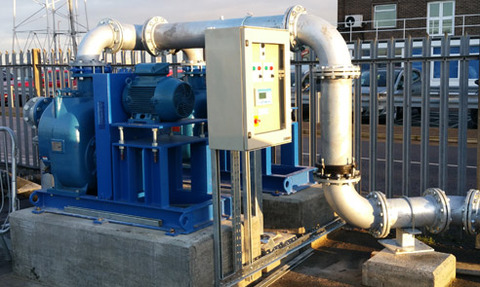Case study: pumps rescue port from drainage dilemma
9 Aug 2016

A surface-mounted pumping station has solved the drainage problems at a major east coast port.
Like many industrial sites that contain large areas of open space, surface water build-up can prove to be a problem.
At the Port of Immingham, surface water has always been removed from the 1,230-acre site via a tidal flap (valve) that drained water from a series of interconnecting chambers and discharge pit directly into the Humber Estuary.
While surface water build-up was not a major threat to the port’s operations, engineers from Associated British Ports (ABP) still saw recurrent blockages as a problem that needed to be resolved on a permanent basis.
The Port of Immingham in North East Lincolnshire is the largest by tonnage in the UK – handling 50 million tonnes annually – and accommodating vessels of up to 130,000 tonnes, so maintaining full operation at all times is essential.
The discharge pit is approximately 1m² so a surface mounted self-priming pump was selected as there was insufficient space in the pit to use submersible pumps.
Mark Redgrove, AxFlow technical support manager
In mid-2015, engineers at the port called on the service of pump distribution and engineering specialist AxFlow, asking it to devise a solution that would eliminate the problem. The company’s proposal was to build a surface-mounted pumping station that would drain the interconnecting chambers and pump the water into the dock.
The pumping station is positioned over the discharge pit and comprises two Wemco WSP6 self-priming pumps, galvanised mild steel pipework, heated jackets for cold weather protection and a control panel c/w pulsar ultrasonic level control.
AxFlow technical support manager Mark Redgrove explains: “The discharge pit is approximately 1m² so a surface mounted self-priming pump was selected as there was insufficient space in the pit to use submersible pumps.
“We also had to take into account the issue of pump maintenance, which is much easier with surface-mounted pumps. The decision to use Wemco WSP6 pumps was made on the grounds that as the run-off water contains grit and solids that collect on the docks, these pumps would easily handle them as they are not affected by solids.”
Broad range
According to AxFlow, the Wemco WSP heavy duty self-priming pump is equally at ease with clean and solidladen liquids, due to its open type two-vane impeller. Suitable for a broad spectrum of applications, the WSP has a differential head capability ranging from 3-42m and can deliver flowrates from 10-700m³/h.
The two six-inch Wemco pumps have been installed by AxFlow on the edge of the pit and have suction legs descending 7.5m into the pit. The run-off water is pumped through 30m of discharge pipework that takes the liquid away to a point where it drops into a dummy sluice.
It is connected to the lock, and as the level of the water in the lock rises and falls, so does the dummy sluice. The water run-off passes out of the dummy sluice into the lock and enters the estuary when the lock gates are opened.
Let it flow
The discharge pit has the capacity to hold from 6-7m³ of water, and once it is empty it soon fills up as water from the interlinked chambers drains into it. The design flow is 200m³/hr, which provides the dock with plenty of surplus capacity, with emptying times being between four and five minutes.
Once the chamber is empty, it can fill up relatively quickly, depending on the rainfall. Due to the fluctuations in the volume of surface water run-off, the pumps are not operating continuously. They are on duty/standby configuration in order that both pumps share the workload.
When one pump has run for a period, the ultrasonic control system will switch operation to the standby that then becomes the duty pump. Should there be very high rainfall, both pumps can operate at the same time to keep the flow at optimum capacity.

